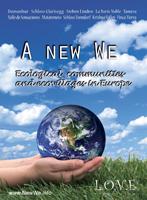Author: Chris Roth
Published in Communities Magazine Issue #150
A New We:
Ecological communities and ecovillages in Europe
DVD, 120 minutes, L.O.V.E. Productions, 2010
www.NewWe.info; fic.ic.org/a-new-we.php
Available from store.ic.org/a-new-we
Two hours does not seem like a lot of time to visit even one community, let alone nearly a dozen. Yet Austrian filmmaker Stefan Wolf has managed to accomplish something amazing: he has created a feature-length film that gives viewers a sense of real familiarity with 10 diverse ecological communities and ecovillages throughout Europe. Even more important, by profiling such a wide variety of communities, all of them mold-breaking experiments in ecological living and cooperation, A New We leaves one with the feeling that the possibilities for such projects are endless. Stefan reminds us that these 10 are just a small subset of thousands of like-spirited experiments worldwide (a glance at the Communities Directory or visit to www.ic.org backs up his assertion), but his film also makes clear that nothing is “cookie-cutter” about these groups—quite the opposite.
Against a backdrop of beautiful videography, each community segment starts with a concise textual profile of the group (including number of residents, land area, organizational structure, percentage of diet produced on site, energy and water sources, etc.) and ends with contact information. In between, we visit each place and hear from some of its residents. The pace is never rushed, and yet each segment covers a wide range of topics, including some of the personal challenges that community members face.
The video tour includes: Damanhur, an Italian network of 1000 people living in 20- to 30-person eco-communities; Schloss Glarisegg, a 34-member Swiss holistic seminar center; La Borie Noble, a 13-member community in France inspired by Gandhian ideals of nonviolence; Krishna Valley, a 150-member Hungarian community with 95 percent food self-sufficiency; Matavenero, whose 70 residents inhabit a formerly abandoned Spanish mountain village rebuilt through the Rainbow movement; Schloss Tonndorf, a 60-resident, especially child-friendly German ecovillage encompassing an old castle; Finca Tierra, a small, nature-based community in the Canary Islands; Sieben Linden, a growing 120-member German ecovillage with a radically reduced ecological footprint and innovative decision-making model; Valle de Sensaciones, a remote Spanish eco-community emphasizing direct experience in nature; and Tamera, a peace education and research center in south Portugal inhabited by 200 people.
While Stefan obviously chose interviewees who believed in each project (rather than seeking out, for example, disillusioned ex-members, of which I would guess there are some), the candid nature of the interviews here make each video portrait both believable and ultimately inspiring. I never felt as if I were being “sold” anything, only given a window into each way of life—one that effectively conveys how hopeful and game-changing these kinds of life choices could be as humanity faces an uncertain future.
Of course, in reality, a 10- to 20-minute video portrait can only scratch the surface of what there is to learn about each group. I sensed that there were many more stories to tell about each place, which a video of this length could never hope to include. Based on my own community experiences, I could sense (or project) unspoken dynamics and issues into several of the settings. I never found myself rolling my eyes, but I did raise my eyebrows at the opening of one segment, in which the female cofounder is peddling away on a human-powered washing machine while her male partner lounges in a hottub and philosophizes about luxuriating in the senses. (Later, though, this comically unbalanced first impression is corrected when he introduces us to an intriguing mandala game he designed to distribute household tasks in a fair and fun way.) In another segment, I couldn’t help but wonder about the power dynamics in a small community created by a single visionary individual; and in another, about whether members might eventually backtrack on their current degree of buy-in to a shared spiritual philosophy, and whether there were any “doubters” that we didn’t meet.
But none of these questions derailed the experience of watching the video; instead, they just provoked more curiosity. I found myself interested in learning more about every situation.
This English-language edition of the original foreign-language film includes overdubs and, where more appropriate, subtitles—done, mostly, with skill, and always understandable.
A New We could not have come at a better time. It can benefit both current communitarians/ecovillagers and those who don’t yet even know that eco-communities exist. It opens our eyes to the amazing diversity of approaches to eco-community that are possible—and even more important, to the fact that those dreams are being put into practice by real people, in real life, at various places all over the globe.

















graceonline
Chris, I am grateful to find your review of the film. You addressed a number of questions that came to mind as I viewed the trailer. I can’t wait to learn more about that mandala game and how it helps with household chore distribution!
I’ve added the trailer and a link to this article on my “”What are sustainable communities?”” web page at http://www.squidoo.com/what-are-sustainable-communities#module152347908. I am sure both will be of use to my readers.